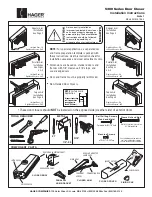
Page 20
Power supply
Most applications of gas metal arc welding
use a constant voltage power supply. As a
result, any change in arc length (which is
directly related to voltage) results in a
large change in heat input and current. A
shorter arc length will cause a much
greater heat input, which will make the
wire electrode melt more quickly and
thereby restore the original arc length.
This helps operators keep the arc length
consistent even when manually welding
with hand-held welding guns. To achieve a
similar effect, sometimes a constant
current power source is used in
combination with an arc voltage-controlled
wire feed unit. In this case, a change in arc
length makes the wire feed rate adjust in
order to maintain a relatively constant arc
length. In rare circumstances, a constant
current power source and a constant wire
feed rate unit might be coupled, especially
for the welding of metals with high thermal
conductivities, such as aluminum. This
grants the operator additional control over
the heat input into the weld, but requires
significant skill to perform successfully.
Alternating current is rarely used with
GMAW; instead, direct current is
employed and the electrode is generally
positively charged. Since the anode tends
to have a greater heat concentration, this
result in faster melting of the feed wire,
which increases weld penetration and
welding speed? The polarity can be
reversed
only
when
special
emissive-coated electrode wires are used,
but since these are not popular, a
negatively charged electrode is rarely
employed
Technique
The basic technique for GMAW is quite
simple, since the electrode is fed
automatically through the torch. By
contrast, in gas tungsten arc welding, the
welder must handle a welding torch in one
hand and a separate filler wire in the other,
and in shielded metal arc welding, the
operator must frequently chip off slag and
change welding electrodes. GMAW
requires only that the operator guide the
welding gun with proper position and
orientation along the area being welded.
Keeping a consistent contact tip-to-work
distance (the
stick out
distance) is
important, because a long stick out
distance can cause the electrode to
overheat and will also waste shielding gas.
Stick out distance varies for different
GMAW weld processes and applications.
For short-circuit transfer, the sickout is
generally 1/4 inch to 1/2 inch, for spray
transfer the stick out is generally 1/2 inch.
The position of the end of the contact tip to
the gas nozzle are related to the stick out
distance and also varies with transfer type
and application. The orientation of the gun
is also important—it should be held so as
to bisect the angle between the work
pieces; that is, at 45 degrees for a fillet
weld and 90 degrees for welding a flat
surface. The travel angle, or lead angle, is
the angle of the torch with respect to the
direction of travel, and it should generally
remain approximately vertical. However,
the desirable angle changes somewhat
depending on the type of shielding gas
used—with pure inert gases; the bottom of
the torch is often slightly in front of the
upper section, while the opposite is true
when the welding atmosphere is carbon
dioxide.






































